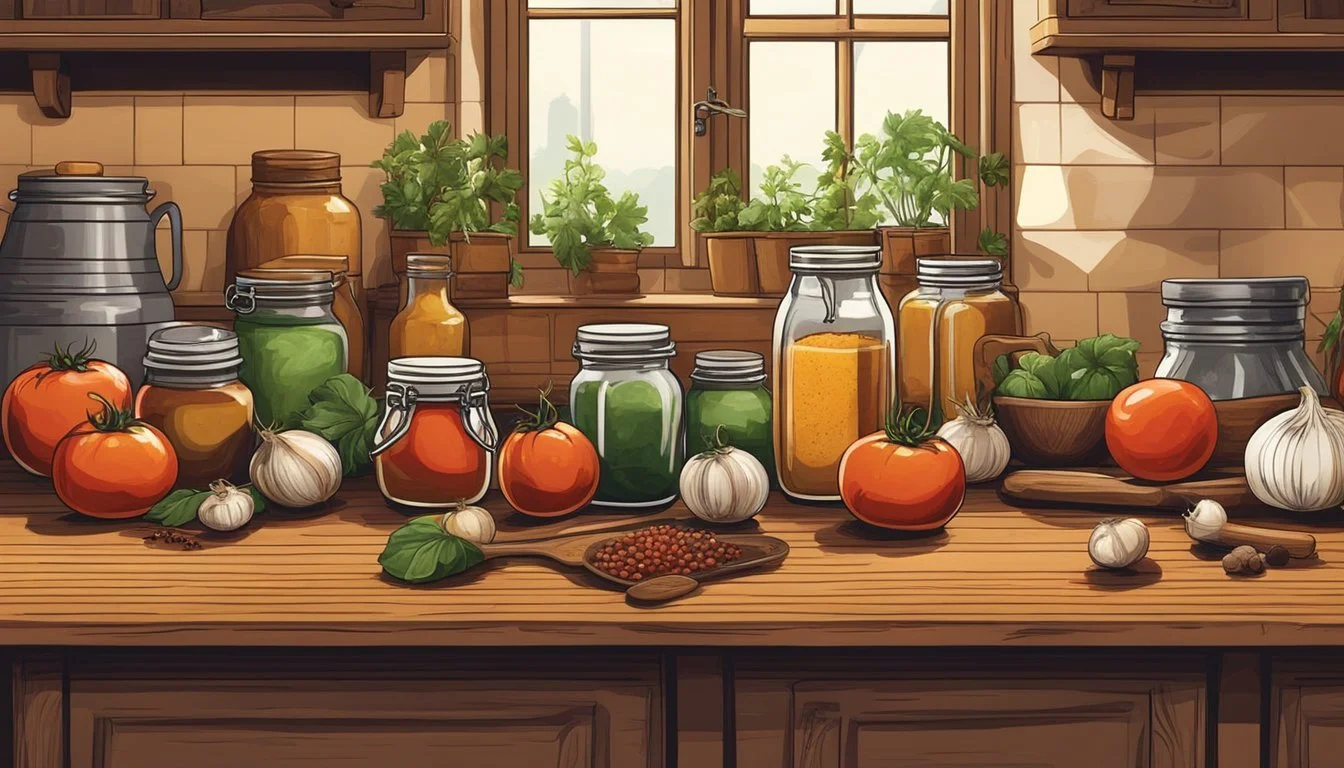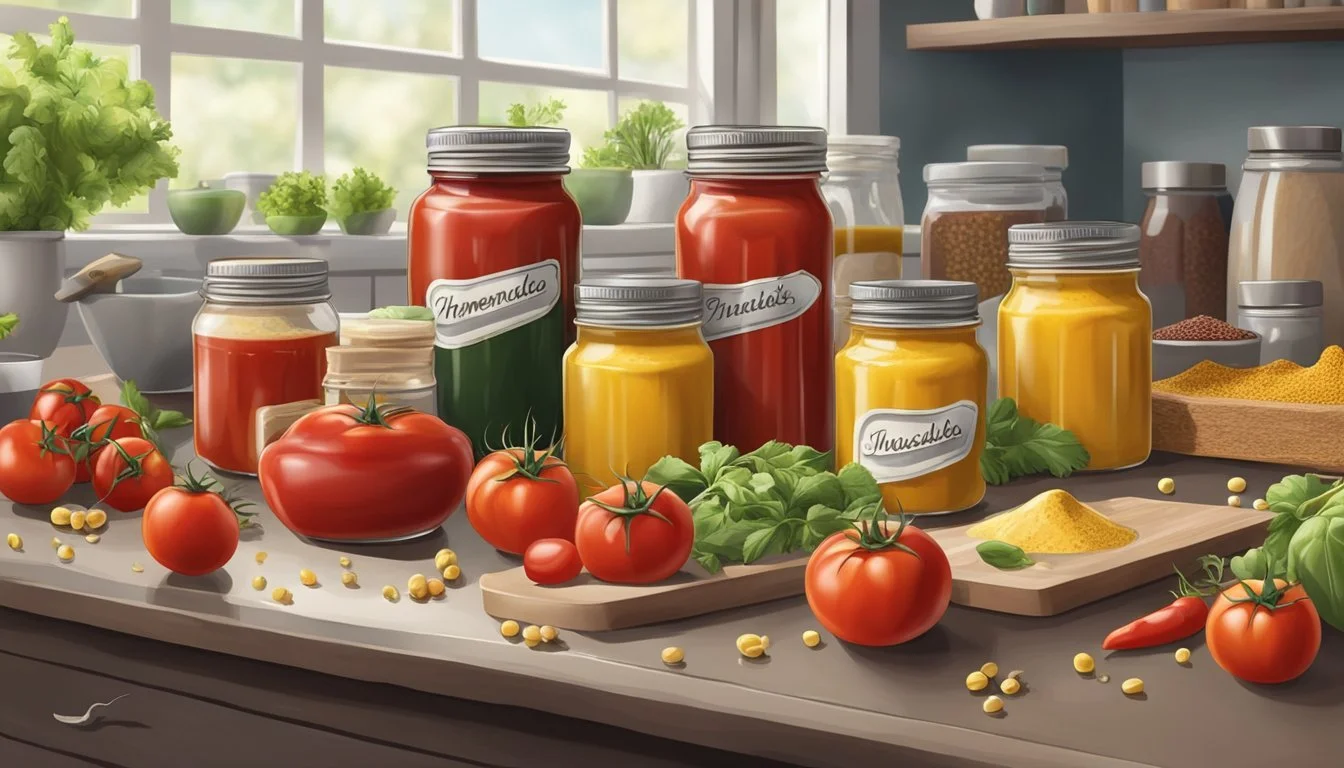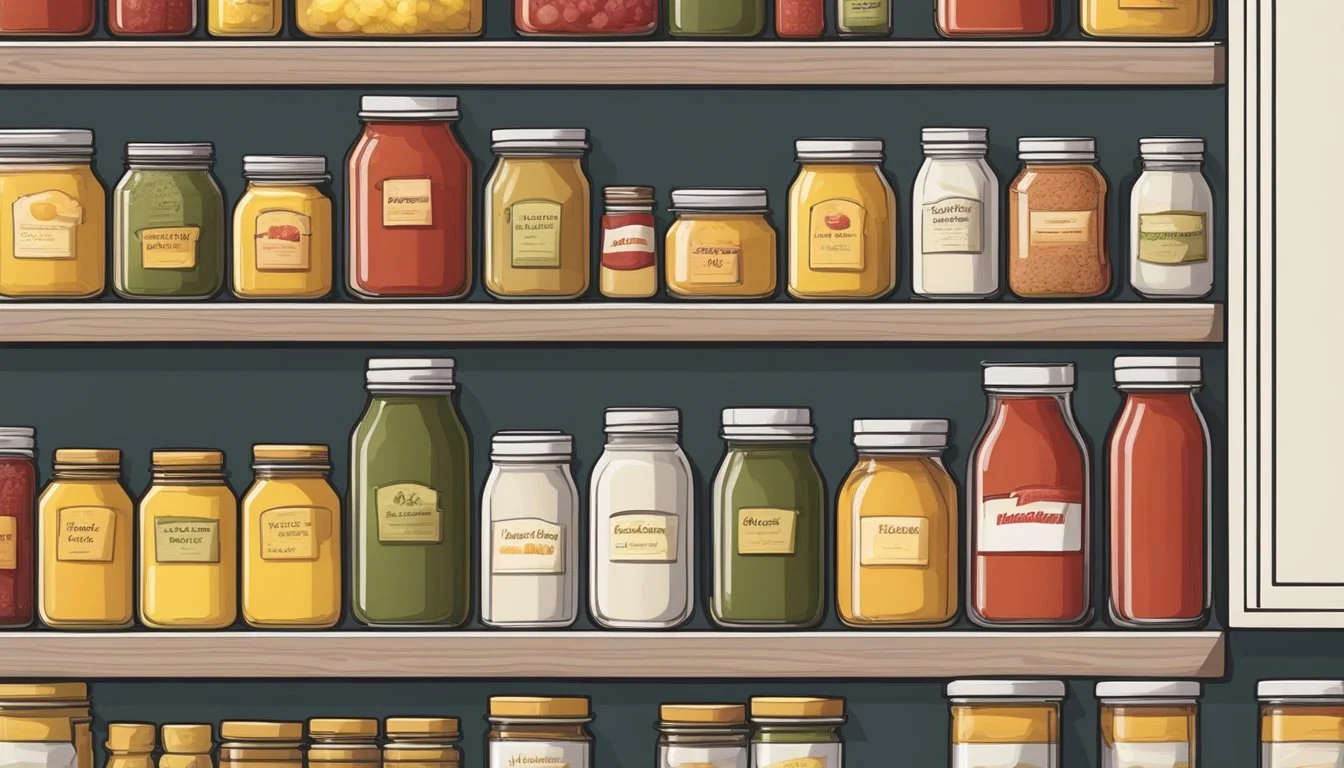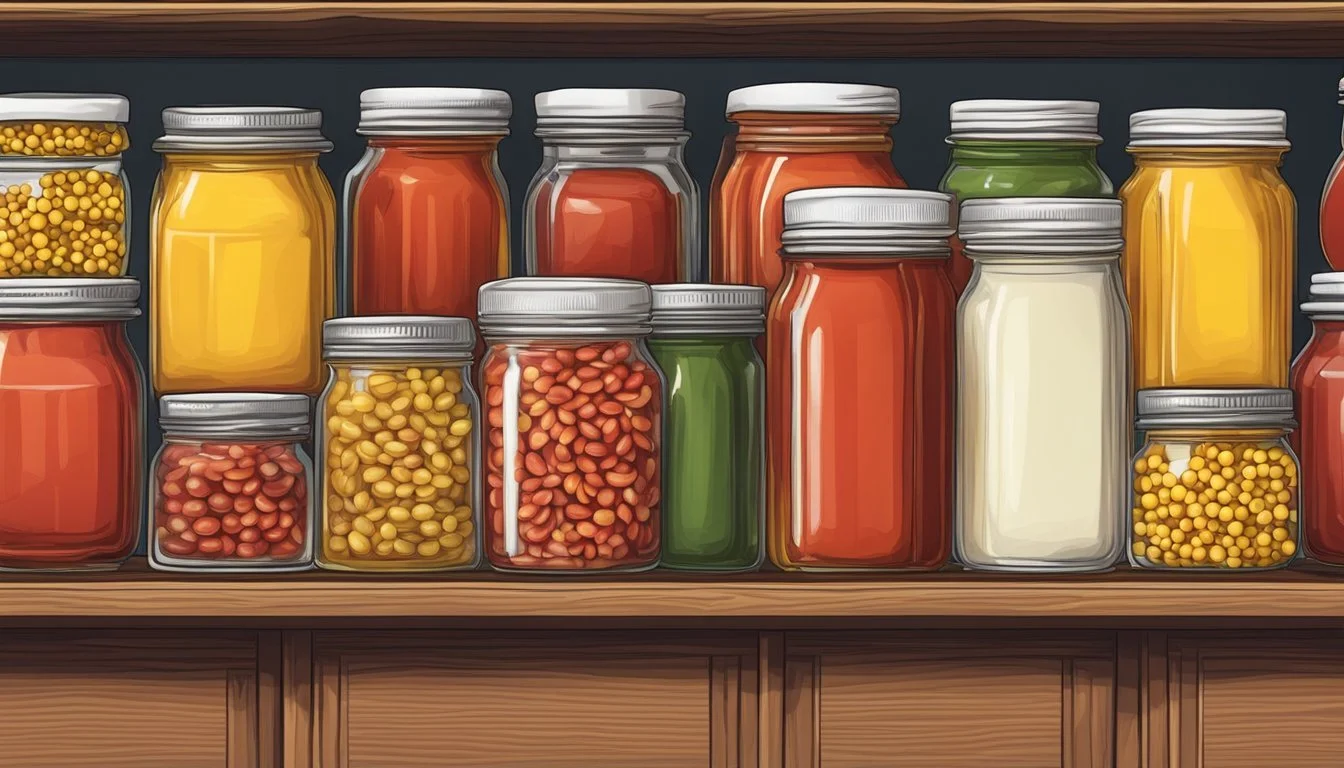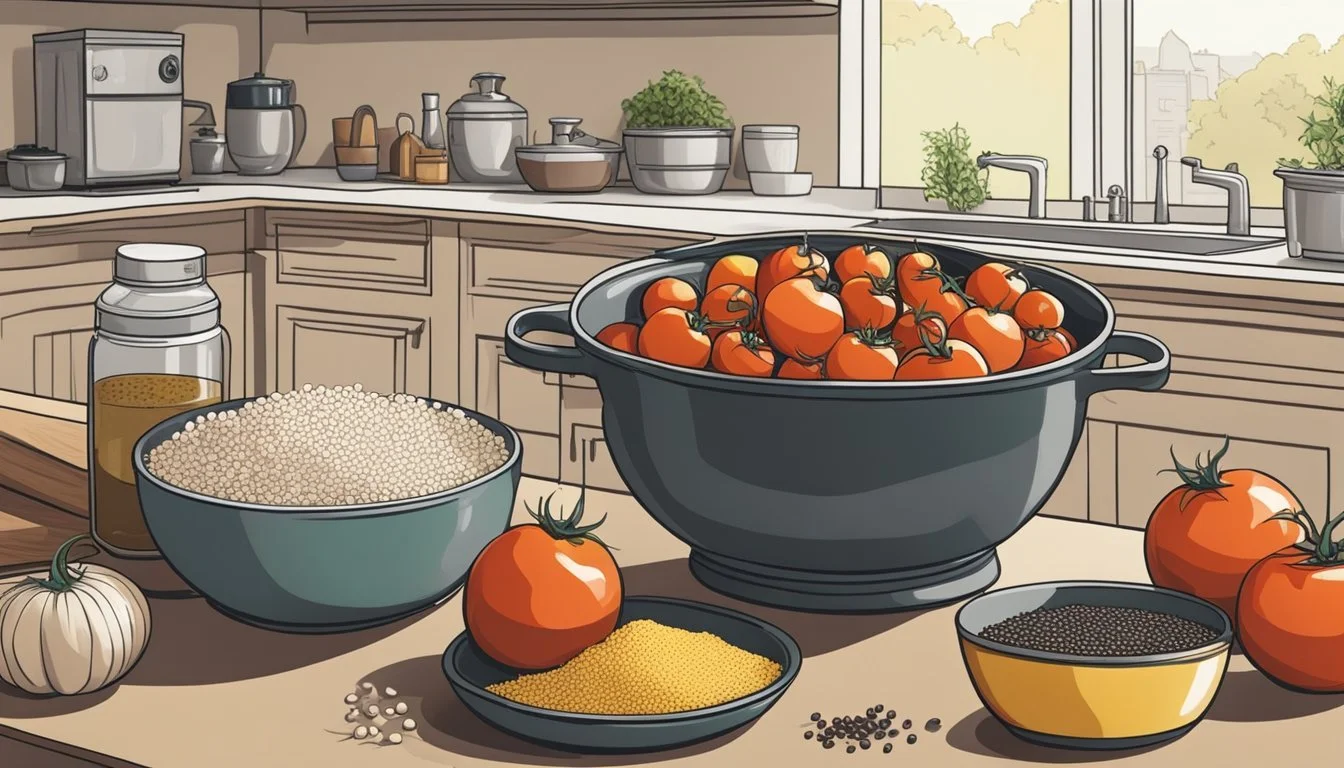Pantry-Friendly Homemade Ketchup and Mustard Recipes
Easy and Flavorful Condiments
Making condiments from scratch can be a straightforward and rewarding process, especially when focusing on classics like ketchup and mustard. Pantry-friendly homemade ketchup and mustard recipes allow for customization according to personal tastes while utilizing simple, readily available ingredients. These staples can easily be made with items commonly found in kitchen cupboards, such as vinegars, spices, sweeteners like honey, and tomato paste for ketchup. The advantage of homemade versions is not just in the potential health benefits of avoiding preservatives and additives, but also in the fresh, rich flavors they can bring to meals.
Homemade ketchup typically combines tomato paste with a sweetener, several seasonings, and vinegar to achieve a familiar tangy-sweet balance. The cooking process, which involves simmering the ingredients, helps to meld the flavors and achieve a desirable consistency without much complexity. Likewise, mustard can be made by whisking together mustard powder or seeds with a selection of other ingredients and then simmering to reach the desired thickness. The simplicity of these recipes supports a do-it-yourself approach, enabling even the most novice home cooks to prepare these condiments with success.
Creating condiments at home not only allows for a pantry-friendly approach to food preparation but also supports a more sustainable lifestyle by reducing packaging waste. Home cooks can store their homemade ketchup and mustard in reusable glass jars, keeping them fresh in the refrigerator for up to two weeks, which underscores the practicality of the homemade approach for everyday cooking. These recipes provide an excellent starting point for those looking to take the first step into making more of their food from scratch, confident in the knowledge that the end product will be both delicious and additive-free.
Essentials of Homemade Condiments
Making homemade condiments like ketchup and mustard allows for greater control over flavor and ingredients. This section focuses on the fundamentals needed to create these pantry staples successfully.
Ingredient Benefits
Salt: Enhances the overall flavor profile of condiments and acts as a natural preservative.
Pepper: Adds a slight heat and depth to the taste, complementing the tanginess of ketchup or the sharpness of mustard.
Garlic: Provides a robust flavor foundation, especially for mustard, and contributes to the complexity of ketchup.
Oil: Used sparingly to create emulsions or enhance texture.
Vinegar: The acidic component that gives ketchup its distinctive tang and mustard its bite.
Honey/Sugar: These sweeteners balance the acidity from the vinegar in ketchup, contributing to a well-rounded flavor.
Water: Often used to adjust consistency and help blend the ingredients smoothly.
Equipment Checklist
Mixing bowls: For initial ingredient combination.
Saucepan: Required for cooking down ketchup.
Blender or food processor: Needed for ensuring a smooth ketchup texture.
Storage containers: Glass jars with lids are ideal for long-term storage.
Measuring spoons and cups: For precise ingredient portioning.
Whisk or spoon: For stirring and combining ingredients.
Understanding Condiment Textures
Ketchup:
Aim for a smooth and thick consistency that coats a spoon.
Cooking down the mixture on a low simmer and blending well are key steps.
Mustard:
Typically has a more robust texture, ranging from grainy to smooth depending on the grinding process.
The consistency can be adjusted with the amount of water or vinegar used.
The Foundation of Ketchup
Homemade ketchup starts with a robust base of tomatoes (What wine goes well with tomatoes?), complemented by a careful balance of sweetness and acidity, and can be customized with a variety of seasonings to create unique flavor profiles.
Selecting Tomatoes
The choice of tomatoes is crucial for homemade ketchup. For rich flavor and a suitable thickness, one can opt for plum tomatoes or tomato paste, as they have less water content and more flesh. One might also consider using a combination of tomato sauce and tomato paste for convenience, ensuring the foundation has a concentrated tomato base.
Balancing Flavors with Sugar and Vinegar
To achieve the characteristic tang of ketchup, vinegar is essential. Apple cider vinegar or white vinegar typically does the job. The sourness is then balanced with a sweetening agent. While regular sugar is commonly used, using brown sugar can impart a subtle molasses note to the ketchup. The ratio of sugar and vinegar determines the ketchup's tang and should be adjusted to one's preference.
Seasoning and Spice Variations
The seasonings are where homemade ketchup can truly be tailored. A basic ketchup might include salt and common seasonings such as onion powder, garlic powder, and paprika. However, one can experiment by adding spices like allspice or chili powder for a kick or cumin for depth. One's choice of spices and seasonings will ultimately define the ketchup's final character.
Perfecting Homemade Mustard
Creating a quality homemade mustard involves understanding the different seed varieties, mastering preparation techniques, and personalizing the flavors to suit taste preferences. By focusing on these aspects, one can craft an exceptional mustard that can rival any store-bought version.
Mustard Seed Varieties
The type of mustard seeds used in a recipe dramatically influences the taste and potency of the finished condiment. There are primarily two types of seeds: yellow mustard seeds, which are mild and less pungent, and brown mustard seeds, known for their spicier and more robust flavor. Some recipes also use black mustard seeds, which have a strong, sharp taste.
Yellow Mustard Seeds (Mild): Ideal for a more universally palatable mustard.
Brown Mustard Seeds (Mid-Spicy): Suited for those seeking medium heat.
Black Mustard Seeds (Hot): Best for daring palates that appreciate intense warmth.
Mustard Preparation Techniques
The process starts with soaking the mustard seeds in a liquid, typically vinegar or water, which helps to mellow their raw heat. The choice of liquid can also add different flavor notes to the mustard. After soaking, usually for a period spanning 24 to 48 hours, the seeds are ground, which releases the oils and enzymes that develop the mustard's final flavor and texture.
Soaking: Mustard seeds need to be soaked in vinegar or water to soften and mellow their taste.
Grinding: Using a food processor, mortar and pestle, or a spice grinder, the seeds are ground to achieve the desired consistency.
Customizing Mustard Flavors
Making mustard at home allows individuals to experiment and tailor the flavor profiles. Honey can be added for a touch of sweetness to balance the sharpness of the mustard. Salt is essential for seasoning, while an array of spices like turmeric, garlic powder, or herbs may be employed to introduce complexity and depth.
Sweeteners: To make a honey mustard, mix in honey after the mustard is ground.
Seasonings: Salt is fundamental for enhancing the mustard’s overall flavor.
Spices and Herbs: Incorporate spices such as turmeric for color and health benefits, or dried herbs for additional layers of taste.
Recipe Creation and Cooking Methods
Creating homemade condiments like ketchup and mustard allows for customizable flavors and the satisfaction of knowing exactly what's in them. Both recipes typically involve simmering ingredients to blend flavors and achieve the desired consistency.
Ketchup From Scratch
One begins by selecting quality tomatoes as the foundation for their ketchup, as they impart the primary flavor. The process involves simmering a blend of tomato sauce and paste with a selection of sweeteners, such as sugar or honey, and a variety of spices. Apple cider vinegar and white vinegar are also common inclusions for tanginess. It is crucial to maintain a gentle simmer, often for around 20 minutes, to allow the ingredients to meld together. The mixture should be stirred often to prevent sticking and ensure even cooking. After simmering, one can blend the ketchup until it's smooth and store it in a glass container. It should be noted that cooking times may vary slightly based on the desired thickness.
Basic Ingredients:
Tomatoes (sauce and paste)
Sweeteners (sugar, honey)
Vinegars (apple cider, white)
Spices (onion powder, garlic powder, paprika)
Key Steps:
Combine ingredients in a saucepan.
Simmer over low heat, stirring frequently.
When thickened, blend until smooth.
Quick and Easy Mustard Recipes
Mustard is typically easier and quicker to make than ketchup due to its simpler process. Homemade mustard recipes often start with mustard seeds or ground mustard powder. These are then mixed with liquids such as water, vinegar, or even wine, to create a paste. Additional flavorings like salt, herbs, and spices can be included according to one's taste preferences. As opposed to ketchup, mustard doesn't always require cooking; however, some recipes may call for a brief sauté of spices or simmering of the mustard mixture to deepen the flavors. It's often advised to let the mustard rest for a period after preparation to allow the flavors to develop fully.
Essential Ingredients:
Mustard seeds or powder
Liquid (water, vinegar, wine)
Seasonings (salt, herbs, spices)
Typical Moves:
Mix mustard base and liquids to form a paste.
Optional: Sauté or simmer with additional spices.
Let the mustard rest to intensify the flavors.
Pantry Storage Tips
When preparing homemade ketchup and mustard, understanding how to store these pantry-friendly items is crucial. This knowledge ensures flavors are preserved and shelf life is maximized without compromising safety or quality.
Maximizing Shelf Life
Homemade ketchup and mustard are best kept in a cool, dark place to prolong their shelf life. The pantry should be dry and maintain a consistent temperature. One must ensure items are kept in airtight containers to prevent exposure to air and moisture, which can degrade the condiments. For homemade ketchup, while it may contain preservatives like sugar and vinegar, it's important to store properly to maintain its flavor for future use.
Ketchup: After cooling, transfer to glass jars with tight-fitting lids.
Mustard: Store in non-reactive containers, as mustard can be acidic.
Best Practices for Storage
For both ketchup and mustard, following storage best practices guarantees the longevity and freshness of these condiments. Homemade versions lack the preservatives of commercial products, so one must be diligent in how they are stored.
Ensure all containers are clean before filling.
Label containers with the date of creation.
Consider making small batches that can be used within a few weeks.
If larger quantities are made, freezing in appropriate containers is an option, but may affect texture upon thawing. Leave space at the top of containers when freezing to allow for expansion.
Always use clean utensils when serving to maintain the integrity of the condiments.
By implementing these tips, homemade ketchup and mustard can remain pantry staples that are both make-ahead friendly and delicious.
Serving Suggestions
Homemade ketchup and mustard are versatile condiments that can enhance the flavors of various meals and dishes. Their homemade quality adds a personal touch to food, inviting home cooks to experiment with pairings and applications.
Pairing with Meals
Homemade ketchup is a classic complement to comfort food. It pairs exceptionally well with:
Bread: Elevate sandwiches or toast with a spread of homemade ketchup or mustard.
Meats: Enhance the taste of grilled or roasted meats (What wine goes well with roasted meats?), sausages, and meatloaf.
Vegetables: Offer a sweet and tangy dip for raw or fried vegetables.
Eggs: Add a squirt of ketchup to scrambled or fried eggs for extra flavor.
For mustard, think beyond sandwiches by incorporating it into dressings for salads or as a layer on cheese platters.
Creative Uses in Dishes
The role of homemade condiments extends into culinary creativity. Consider these ideas:
Cheese: Blend mustard into cheese sauces or as part of a glaze for baked cheese dishes.
Butter: Mix ketchup or mustard into softened butter for a unique compound butter.
Vegetables: Create a marinade with mustard for roasted vegetables.
Eggs: Swirl ketchup into an omelet mixture for a color and flavor twist.
By incorporating homemade ketchup and mustard in these ways, home cooks can discover new depths of flavor in everyday foods.
Special Dietary Considerations
When crafting homemade ketchup and mustard recipes, it's important to consider dietary restrictions such as gluten intolerance and the principles of vegan and vegetarian diets. Careful selection of ingredients ensures these condiments can be enjoyed by individuals with these specific dietary needs.
Gluten-Free Options
Ketchup and mustard are typically gluten-free, but certain additives or thickening agents in commercial brands may contain gluten. For homemade recipes, gluten-free cooks should ensure all purchased ingredients such as vinegar or any packaged spices are certified gluten-free. Here’s a quick checklist for gluten-free ketchup and mustard preparation:
Verify ingredients: Check labels for gluten-free certification.
Cross-contamination: Use clean utensils and surfaces to avoid cross-contamination with gluten-containing products.
Vegan and Vegetarian Variants
Most ketchup and mustard recipes are naturally vegetarian, typically containing no animal-derived ingredients. However, vegan cooks need to ensure that all sugar used in ketchup is not processed with bone char, a common non-vegan filtering process. Additionally, some mustards may contain honey, which is not vegan-friendly. Here are key points for vegan and vegetarian ketchup and mustard:
Sweeteners: Use alternatives like agave syrup or maple syrup in place of honey or non-vegan sugars.
Worcestershire sauce: Some ketchup recipes call for Worcestershire sauce, which usually contains anchovies. (What wine goes well with anchovies?) Look for a vegan alternative or omit altogether.
By keeping these considerations in mind, homemade ketchup and mustard can be made inclusive to those with gluten-free and plant-based dietary preferences.
Enhancement Through Blends
When embarking on the creation of homemade ketchup and mustard, one can elevate the basic recipes by incorporating international flavors and creating signature blends. These enhancements are achieved through the deliberate selection of herbs, spices, and tangy elements, which can transform homemade condiments into gourmet creations.
Incorporating International Flavors
Spices: A kitchen artisan can introduce international flair into ketchup by using spices commonly found in global cuisines. For example, a Moroccan-inspired ketchup could include a blend of cumin, coriander, and a pinch of cinnamon, offering warm and complex notes.
Cumin
Garam Masala
Turmeric
Herbs: Herbs such as oregano or thyme can be used to impart an Italian or French touch to mustard. Fresh herbs should be finely chopped to distribute their flavor evenly.
French Herb Mix for Mustard:
Tarragon
Chervil
Parsley
Creating Signature Blends
Tangy Additions: Incorporating tangy ingredients into ketchup and mustard can add a distinct sharpness that enhances their profiles. For ketchup, a splash of balsamic vinegar can provide a rich tanginess, while mustard might be elevated with the addition of apple cider vinegar.
Signature Ketchup Tang:
Balsamic Vinegar
Signature Spices: Creating a signature blend for ketchup might include smoked paprika for a subtle smokiness, while mustard could be enhanced with a combination of yellow and black mustard seeds for depth and heat.
Signature Mustard Seed Blend:
Yellow Mustard Seeds
Black Mustard Seeds
Crushed Mustard Seeds (for texture)
User Contributions and Variations
In the world of homemade condiments, variations are as diverse as the individuals crafting them. Contributors to the homemade ketchup and mustard recipes realm often share their unique tweaks, providing reviews and ratings that offer guidance on taste and consistency adjustments.
Community Recipes
Community-generated recipes are a treasure trove of culinary creativity. They often include:
Personal Ratings: Users typically rate recipes on a scale of 1 to 5 stars, reflecting their satisfaction with the final product.
Comments Sections: These areas are rich with suggestions for substitutions, additional spices, or techniques to improve the recipe.
Examples of user-contributed ketchup and mustard recipe tweaks include:
Ingredient Ketchup Variations Mustard Variations Sweeteners Users often substitute sugar with honey, molasses, or brown sugar Alternative sweeteners like maple syrup or honey are recommended Spices Additions like cayenne or paprika lend a kick Turmeric, garlic, or dill can create diverse flavor profiles Vinegars or Acids Some prefer apple cider vinegar for a milder tang Choice of vinegar can vary from white wine to balsamic Thickness Adjustments include cooking time alterations or blending Mustard seed grind size can influence texture
Adjusting Recipes for Taste and Consistency
Fine-tuning recipes to suit individual palates can involve:
Taste: Reviewers may suggest increasing or decreasing specific spices to better align with their flavor preferences.
Consistency: Some may comment on the texture, often advising on whether to blend for smoothness or alter simmering time for desired thickness.
A recipe's adaptability is a testament to its foundation; thus, proposed variations that consistently receive positive feedback highlight a recipe's robustness. Those who diligently document their adjustments help others navigate flavor and texture to achieve a personalized condiment.
Homemade ketchup and mustard enthusiasts take great pride in refining these staple sauces, and the collective input creates a continuously evolving repository of taste-tested variations.
Health and Nutritional Perspectives
Homemade ketchup and mustard offer control over ingredients, allowing individuals to tailor recipes for health and nutritional benefits. This section delves into the caloric content and the macro and micro nutrient breakdown of these condiments.
Caloric Content
Homemade ketchup typically contains fewer calories than store-bought versions due to the absence of high fructose corn syrup and other additives. For instance, a tablespoon of standard homemade ketchup may contain about 15-20 calories, depending on the sweeteners and ingredients used. In contrast, commercial varieties often contain about 20 calories for the same serving size, but with a higher percentage of these calories coming from added sugars.
Mustard, on the other hand, is naturally low in calories, with a tablespoon of homemade mustard averaging between 5-10 calories. This low caloric density makes mustard a healthier option for those monitoring their calorie intake.
Macro and Micro Nutrient Breakdown
The nutritional value of homemade ketchup and mustard is determined by their ingredients:
Homemade Ketchup: Often made with tomato paste, vinegar, a sweetener like honey or maple syrup, and various spices, homemade ketchup provides a modest source of vitamins A and C, potassium, and dietary fiber. The use of natural sweeteners can also offer small amounts of minerals such as calcium and iron.
Nutrient Approximate Amount per Tablespoon (15g) Dietary Fiber 0.15g Vitamin A 5% of RDA Vitamin C 3.5% of RDA Potassium 50mg
Homemade Mustard: Typically consisting of mustard seeds, vinegar, water, and spices, homemade mustard packs a range of micronutrients. Mustard seeds are a good source of selenium and omega-3 fatty acids. They also contain magnesium, phosphorus, and various B-complex vitamins.
Nutrient Approximate Amount per Tablespoon (15g) Selenium 22µg Omega-3 0.07g Magnesium 5mg Phosphorus 10mg
Both homemade ketchup and mustard contribute to health and nutrition by offering more control over sodium levels as well, which can be beneficial for those with dietary restrictions related to blood pressure or heart health.

